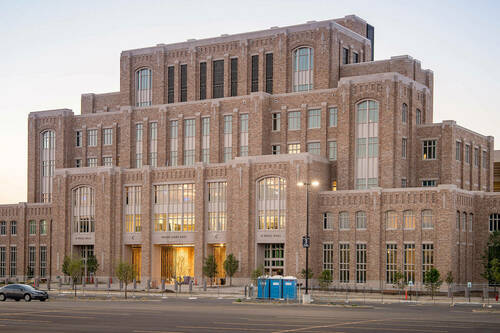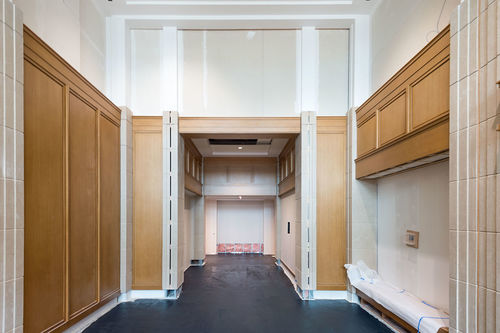
 O’Neill Hall, on the south side of Notre Dame Stadium, is the new home of the Department of Music and the Sacred Music at Notre Dame program.
O’Neill Hall, on the south side of Notre Dame Stadium, is the new home of the Department of Music and the Sacred Music at Notre Dame program.
Informally, the 175-seat LaBar Family Recital Hall inside Notre Dame’s O’Neill Hall is known as the “jewel box” because of its elegant, classic design and intimate size.
But in fact, all of O’Neill Hall is a jewel box — expertly and beautifully designed as a home to the students and faculty, the artists and instruments in the University’s Department of Music and Sacred Music at Notre Dame (SMND) program.
“O’Neill Hall’s many attractive features are too numerous to list,” said Peter Smith, professor of music theory and chair of the department. “The exquisite performance spaces and an overall design that supports a community of scholarship and learning will make O’Neill a magnet for the most in-demand guest artists and scholars, the most stimulating conferences and performances, and the most outstanding students and faculty.”
 The LaBar Family Performance Hall takes shape inside O’Neill Hall.
The LaBar Family Performance Hall takes shape inside O’Neill Hall.
The 100,000-square-foot, seven-story building on the south side of Notre Dame Stadium was made possible by a gift to the University from Helen Schwab and her husband Charles, in honor of her brother, Notre Dame alumnus and trustee Joseph I. O’Neill III.
It also features the innovative, 175-seat LaBar Family Performance Hall — a versatile venue that offers flexible seating and staging options and will accommodate events involving music in combination with other media, such as projected text and visual images, and other forms of artistic expression, such as acting, lighting, and dance.
In addition to performance spaces, O’Neill Hall includes a music library, a lab for studio production, a lecture hall, classrooms and rehearsal spaces, numerous practice rooms, and faculty offices for both the Department of Music and the rapidly growing SMND program.
“I am thrilled and gratified that Notre Dame has made this commitment to sacred music, which is such a natural fit for the University and its mission,” said Margot Fassler, director of SMND and Keough-Hesburgh Professor of Music History and Liturgy. “A well-equipped space was the missing piece in our program, and this building provides exactly what we need.”
 A first-floor hallway in O’Neill Hall.
A first-floor hallway in O’Neill Hall.
Not only does O’Neill Hall nearly quadruple the space available to the Department of Music and Sacred Music at Notre Dame program— from 9,000 to 34,000 square feet — but it also offers sophisticated acoustical design, sound isolation, and climate control throughout the building.
“Our teaching and research missions will flourish in an environment designed with great care by the architects,” Smith said. “In each room of O’Neill Hall, students and faculty will hear only what they need to hear — the music they are studying within that space. Temperature and humidity will also remain at constant levels ideal for musical instruments.
“The change will be transformational for scholarship, performance, pedagogy, and instrument maintenance.”
Among those instruments are four organs and 55 pianos — including a 9-foot Steinway concert grand piano, three 7-foot baby grand pianos, and 11 uprights purchased for the new building and valued at more than $600,000.
At the center of the third floor is the music library and its diverse collection of resources — a gathering space envisioned as the heart of O’Neill Hall. Its lounge spaces and study areas will host informal interactions between students and faculty flowing out of classrooms and rehearsal halls.
 The entrance to O’Neill Hall, a 100,000-square-foot, seven-story building housing performance and rehearsal spaces, classrooms, and a music library.
The entrance to O’Neill Hall, a 100,000-square-foot, seven-story building housing performance and rehearsal spaces, classrooms, and a music library.
The library, in keeping with the other interiors in O’Neill Hall, was thoughtfully crafted with sweeping, curving surfaces, collaborative spaces, and the latest technology.
But the true beauty of the building, Fassler said, lies in how well it reflects the vision of the two academic programs it houses.
“O’Neill Hall reflects what Music and Sacred Music are and how we work. There is space for performers and space for scholars, and space for us to all come together,” Fassler said. “When architecture is well done, it sustains and proclaims your mission. And that’s what this building will do.”
Originally published by at al.nd.edu on October 27, 2017.